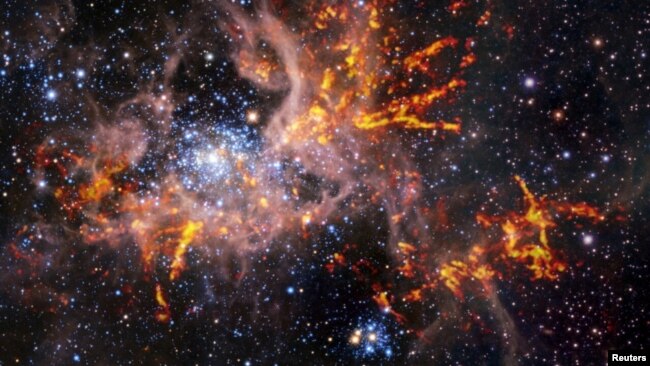地球から約17万光年の距離(頭も目もくらむ)にあるタランチュラ星雲の研究が、星の形成メカニズム、宇宙の初期を知る手がかりになるのですね!!
”Tarantula Nebula” 君はかくも美しく、私を魅了する!!
VOAで英語を学びましょう!!
忘れかけた単語の復習、脳への復讐!!
タランチュラ星雲で星の形成を研究(和訳)
Scientists Study Tarantula Nebula to Learn about Star Formation
June 20,2022
タランチュラ星雲を研究している科学者たちは、星がどのように形成されるのかについて、より深い理解を得ることができたと述べています。
研究者たちは、天の川銀河に隣接するガスと塵の大きな雲の美しい画像も手に入れました。
研究者たちは最近、この観測から、重力とフィードバックという2つの競合するプロセスの関連性について情報を得たと述べています。重力は星形成を促進する力ですが、フィードバックとして知られる競合するプロセスは、大きな若い星が星の成長を制限するために近くの環境に大量のエネルギーを導入することを指します。
タランチュラ星雲は、600光年ほどの大きさの星やガス、塵が集まった領域です。1光年は、光が1年間に進む距離です。- 約9兆5千億キロメートル。
タランチュラ星雲の正式名称は旗魚座30(30Doradus)です。地球から約17万光年の距離にあります。
ガスと塵と星が織りなす道がクモの足のように見えることから、タランチュラ星雲と呼ばれています。この星雲のガスの混合物は、初期宇宙のものとよく似ています:ほとんどが水素とヘリウム。
ヨーロッパ南天天文台が公開したタランチュラ星雲の画像には、より大きな星雲の残骸と思われる薄いガス雲が写っています。科学者たちは、大きな若い星からの大きなエネルギーの爆発が、ガス雲を引き裂いたのではないかと考えています。
アストロフィジカル・ジャーナル誌に掲載されたこの研究の共同執筆者であるグイド・デ・マルキ氏は、アメリカ天文学会の会合でこの研究を発表しています。
「我々は、タランチュラ星雲では、大量のガスとダストが存在する場所で星が形成されていることを確認しています。」と、デ・マルキ氏は述べています。
研究者たちは、チリにあるアルマ望遠鏡の観測によって助けられました。
デ・マルキ氏は、”星は、ガス雲が自らの重力で崩壊し、ガスがどんどん濃くなることで形成される”と説明しています。
彼は、これらのガス雲が、"収縮し、核が恒星エンジン、immense(巨大な)原子炉を起動させるのに十分な温度になるまで温まる "と付け加えました。
Immenseとは、極めて大きいという意味です。
デ・マルキ氏によれば、科学者たちは、非常に大きな星 –太陽より100年倍大きい– が形成され始めると、非常に大きなエネルギーを放出し、より多くの星が形成されるための燃料を停止させると信じていたそうです。
「アルマ望遠鏡によるタランチュラ星雲の美しい観測は、ガスの密度が十分に高いところでは、ガスが落ち続け...新しい星が形成され続けることを示しています。これは興味深く、新しいことです。」と、デ・マルキ氏は付け加えます。
デ・マルキ氏が語ったプロセスはフィードバックと呼ばれ、大きな若い星が光子や高速粒子の形で大量のエネルギーを放出することである。この星雲の組成によって、太陽の200倍もの質量をもつ、特に大きな星が誕生したのです。
この報告書の主執筆者であるトニー・ウォン氏は、タランチュラ星雲は科学者が観測できる最も極端なフィードバック環境であると述べています。
「天文学の大きな謎のひとつは、なぜ今日も星が形成されるのを目撃できるのかということです。」とウォン氏は言っています。
「アルマ望遠鏡の観測は、雲の奥で何が起こっているかに光を当て、重力とフィードバックが星形成の速度を制御するために、どのように影響力を競い合うのかを理解するのに役立ちます。」 と彼は続けました。
Scientists Study Tarantula Nebula to Learn about Star Formation
Scientists studying the Tarantula Nebula say they have gained a greater understanding of how stars form.
The researchers also got a beautiful image of a large cloud of gas and dust that neighbors the Milky Way galaxy.
Researchers recently said their observations offered information about the connection between two competing processes – gravity and feedback. Gravity is the force that drives star formation, while the competing process, known as feedback, refers to the huge amounts of energy that large young stars introduce into their nearby environments to limit star growth.
The Tarantula Nebula is an area of stars, gas and dust 600 light-years across. A light year is the distance light travels in a year - about 9.5 trillion kilometers.
The Tarantula Nebula’s official name is 30 Doradus. It is about 170,000 light years from Earth.
It is called the Tarantula Nebula because its paths of gas, dust and stars look like spider legs. The nebula's gas mixture is much like that of the early universe: mostly hydrogen and helium.
The European Southern Observatory released a Tarantula Nebula image showing thin gas clouds that may be the remains of larger ones. Scientists think great bursts of energy from large young stars may have torn apart the gas clouds.
Guido De Marchi was a co-writer of the research published in The Astrophysical Journal and presented the work at a meeting of the American Astronomical Society.
"We see stars forming where there is a lot of gas and dust available, and there is definitely a lot of it in the Tarantula Nebula," De Marchi said.
Researchers were helped by observations from the Chile-based ALMA telescope.
De Marchi explained that "Stars form when gas clouds collapse under their own gravity and the gas gets denser and denser.”
He added that these gas clouds “contract and warm up until the core is hot enough to start the stellar engine, an immense nuclear reactor."
Immense means extremely large.
De Marchi said that scientists used to believe that when very large stars – those 100 times bigger than the sun – begin to form they release so much energy that they shut off the fuel for more stars to form.
De Marchi added, "The beautiful observations of the Tarantula Nebula obtained with ALMA now show that where the gas is dense enough it continues to fall ... and new stars can keep forming. This is interesting and new."
The process De Marchi talked about is called feedback, in which large young stars release large amounts of energy in the form of photons and high-speed particles. The nebula's composition has led to the creation of particularly large stars, some 200 times as massive as our sun.
Tony Wong, the lead writer of the report, said Tarantula Nebula is the most extreme feedback environment scientists can observe.
"One of the big mysteries in astronomy is why we are still able to witness stars forming today,” Wong said.
He continued, “Observations with ALMA can shine a light on what is happening deep within clouds and help us understand how gravity and feedback compete for influence to keep the rate of star formation under control."
Words in This Story
formation — n. something that is formed or created; the act of forming or creating something
composition — n. the way in which something is put together or arranged
contract — v. to become smaller
stellar — adj. of or relating to the stars
photon — n. a tiny particle of light or electromagnetic radiation
